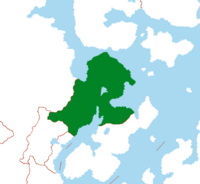Kotowari: Difference between revisions
Lyooonheimer (talk | contribs) No edit summary |
Lyooonheimer (talk | contribs) No edit summary |
||
| Line 163: | Line 163: | ||
==Geography== | ==Geography== | ||
( | Kotowari is located in [[Orient]]al [[Europa]],entirely in the {{wp|Northern Hemisphere}} at the northern-most point of the Menelassar Bay facing the Jasmine Sea to the north. It borders [[Tamurin]] to it's south-west and [[Mahana]] to it's south-east, with [[San Ba]] just across the Jasmine Sea. Despite being well-known for it's flat fertile lands, mountains run across it's borders with both of it's neighbours, notably the [[Samripe Mountain Range|Outer Samripes]] on the border to Mahana. | ||
The Kaṭaṟkarai (coast) facing west is lush and incredibly fertile, being the sole reason for the large concentration of urban areas along the coast. It also is home to fertile valleys and rivers that run into the [[Periya Eri]] (Great Lake) in central Kotowari. There is also areas of large flatlands, suceptible to the [[Narope Rains]] which hit the region once per year. The remainder of the wests natural beauty comes from it's lush {{wp|temperate forest}}s. | |||
<gallery> | <gallery> | ||
Revision as of 20:17, 23 March 2022
People's Republic of Kotowari | |
|---|---|
|
Flag | |
 Map of Kotowari | |
| Capital and | Kotowari City |
| Recognised national languages | |
| Recognised regional languages | |
| Religion | |
| Demonym(s) | Kotowaran or Kotos |
| Government | Unitary Dominant-party Parliamentary Republic |
• President | Krishan Thanurajan |
• Prime-Minister | Bahira Aadhithya |
| Area | |
• | 640,456.47 km2 (247,281.63 sq mi) |
| Population | |
• 2022 estimate | 52,860,000 |
• 2018 census | 52,423,203 |
This article is incomplete because it is pending further input from participants, or it is a work-in-progress by one author. Please comment on this article's talk page to share your input, comments and questions. Note: To contribute to this article, you may need to seek help from the author(s) of this page. |
Kotowari (Ramil: கோட்டோவரி or Kōṭṭōvari (Kelugu: కోటవారి)), officially the People's Republic of Kotowari is a country in Oriental Europa on Eurth. Bounded by the Jasmine Sea to the north, the Rosario Sea to the west and the Menelassar Bay to the south, it shares land borders with Tamurin to the south-east and Mahana to the south-west. It is also within the vicinity of San Ba across the Jasmine Sea.
Historically existing in the form of multiple kingdoms - including the powerful Southern Shakyan Principalities, Kotowari united in the late 17th century following the Kotowari War of Unification, The Kingdom of Kotowari was established officially, following the war, in 1677 under the rule of the Aparnan Dynasty. In 1943, Kotowari became the People's Republic of Kotowari after Queen Leyani II handed power to a parliamentary system from the monarchy, with the royal family being completely dissolved by 1983. Since 1913, Tamurin has been a democracy led by a President, managed by a Prime Minister, and governed by a unitary parliamentary constitutional republic based on the Westminster system.
They are a major power in eastern Europa and arguably Orient's biggest power following Orioni. They are a member of a number of international organisations such as the Assembled Nations, Entente of Oriental States and Oriental Association for Regional Cooperation.
Etymology
The name Kotowari is of Shakyan origin, it stems from original city of Kadofarikh Puri - one of the original eighteen principality city-states named after the title of a Pre-reformed Juruvanic anthropomorphic diety. "Kadoft-Arikht", means Amorphous Skull. The "Kadofarikh" diety was the shapeshifting frog god of chaos, change, and adaptability. The world evolved over the course of history, and according to multiple reliable sources the name 'Kotowari' first appeared in the days of the Madurai Principality of the 13th century.
Geography
Kotowari is located in Oriental Europa,entirely in the Northern Hemisphere at the northern-most point of the Menelassar Bay facing the Jasmine Sea to the north. It borders Tamurin to it's south-west and Mahana to it's south-east, with San Ba just across the Jasmine Sea. Despite being well-known for it's flat fertile lands, mountains run across it's borders with both of it's neighbours, notably the Outer Samripes on the border to Mahana.
The Kaṭaṟkarai (coast) facing west is lush and incredibly fertile, being the sole reason for the large concentration of urban areas along the coast. It also is home to fertile valleys and rivers that run into the Periya Eri (Great Lake) in central Kotowari. There is also areas of large flatlands, suceptible to the Narope Rains which hit the region once per year. The remainder of the wests natural beauty comes from it's lush temperate forests.
History
- Look into Wari culture for similar climate.
- Consider relationship with the Pearl Road network, other Jasmine Sea countries, neighbouring Mahana / Tamurin.
- Joined the EOS in $year.
Politics
(WIP. Government. Political parties. Foreign relations. Military.)
Economy
(WIP. Eployment. Exports. Energy. Transport. Media. Currency.)
Demographics
Juruvanism is followed by most of the Shakeysians while Gaism ("and other Indic religions like Jainism") is followed by the Southerly Ramil ethnicity.
Cultures
Southern Shakeysian culture shares a lot with Sokhainean, as the Sokhaineans are a Southern Shakyan people group. (WIP. Literature. Visual arts. Music. Cuisine. Sport.)


